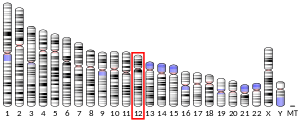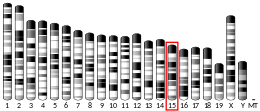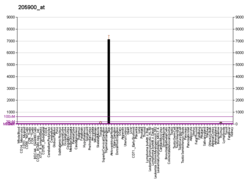Keratin 1
Keratin 1 is a member of the keratin family. It is specifically expressed in the spinous and granular layers of the epidermis with family member keratin 10. Mutations in this gene have been associated with the variants of bullous congenital ichthyosiform erythroderma in which the palms and soles of the feet are affected.
Interactions
Keratin 1 has been shown to interact with Desmoplakin[5] and PRKCE.[6]
gollark: It is a haskell-style not equals.
gollark: That could easily be done with anything which renders to HTML, or indeed basically anything which renders to anything which can display graphics.
gollark: However, when you write a thing in it, it's beneficial if you know how it'll display and it displays the same way on all platforms you like.
gollark: If it wasn't meant to be parsed at all, you wouldn't need the program or any spec whatsoever, yes.
gollark: Parsers also take up several thousand lines of code and are quite hard to extend.
See also
References
- GRCh38: Ensembl release 89: ENSG00000167768 - Ensembl, May 2017
- GRCm38: Ensembl release 89: ENSMUSG00000046834 - Ensembl, May 2017
- "Human PubMed Reference:". National Center for Biotechnology Information, U.S. National Library of Medicine.
- "Mouse PubMed Reference:". National Center for Biotechnology Information, U.S. National Library of Medicine.
- Meng, J J; Bornslaeger E A; Green K J; Steinert P M; Ip W (Aug 1997). "Two-hybrid analysis reveals fundamental differences in direct interactions between desmoplakin and cell type-specific intermediate filaments". J. Biol. Chem. UNITED STATES. 272 (34): 21495–503. doi:10.1074/jbc.272.34.21495. ISSN 0021-9258. PMID 9261168.
- England, Karen; Ashford David; Kidd Daniel; Rumsby Martin (Jun 2002). "PKC epsilon is associated with myosin IIA and actin in fibroblasts". Cell. Signal. England. 14 (6): 529–36. doi:10.1016/S0898-6568(01)00277-7. ISSN 0898-6568. PMID 11897493.
Further reading
- Whittock NV, Ashton GH, Griffiths WA, et al. (2001). "New mutations in keratin 1 that cause bullous congenital ichthyosiform erythroderma and keratin 2e that cause ichthyosis bullosa of Siemens". Br. J. Dermatol. 145 (2): 330–5. doi:10.1046/j.1365-2133.2001.04327.x. PMID 11531804.
- Langbein L, Schweizer J (2005). "Keratins of the human hair follicle". Int. Rev. Cytol. International Review of Cytology. 243: 1–78. doi:10.1016/S0074-7696(05)43001-6. ISBN 9780123646477. PMID 15797458.
- Korge BP, Compton JG, Steinert PM, Mischke D (1993). "The two size alleles of human keratin 1 are due to a deletion in the glycine-rich carboxyl-terminal V2 subdomain". J. Invest. Dermatol. 99 (6): 697–702. doi:10.1111/1523-1747.ep12614149. PMID 1281859.
- Compton JG, DiGiovanna JJ, Santucci SK, et al. (1993). "Linkage of epidermolytic hyperkeratosis to the type II keratin gene cluster on chromosome 12q". Nat. Genet. 1 (4): 301–5. doi:10.1038/ng0792-301. PMID 1284546.
- Rothnagel JA, Dominey AM, Dempsey LD, et al. (1992). "Mutations in the rod domains of keratins 1 and 10 in epidermolytic hyperkeratosis". Science. 257 (5073): 1128–30. Bibcode:1992Sci...257.1128R. doi:10.1126/science.257.5073.1128. PMID 1380725.
- Chipev CC, Korge BP, Markova N, et al. (1992). "A leucine----proline mutation in the H1 subdomain of keratin 1 causes epidermolytic hyperkeratosis". Cell. 70 (5): 821–8. doi:10.1016/0092-8674(92)90315-4. PMID 1381288.
- Dawson SJ, White LA (1992). "Treatment of Haemophilus aphrophilus endocarditis with ciprofloxacin". J. Infect. 24 (3): 317–20. doi:10.1016/S0163-4453(05)80037-4. PMID 1602151.
- Mansbridge JN, Hanawalt PC (1988). "Role of transforming growth factor beta in the maturation of human epidermal keratinocytes". J. Invest. Dermatol. 90 (3): 336–41. doi:10.1111/1523-1747.ep12456286. PMID 2450142.
- Lessin SR, Huebner K, Isobe M, et al. (1989). "Chromosomal mapping of human keratin genes: evidence of non-linkage". J. Invest. Dermatol. 91 (6): 572–8. doi:10.1111/1523-1747.ep12477087. PMID 2461420.
- Popescu NC, Bowden PE, DiPaolo JA (1989). "Two type II keratin genes are localized on human chromosome 12" (PDF). Hum. Genet. 82 (2): 109–12. doi:10.1007/BF00284039. PMID 2470667.
- Johnson LD, Idler WW, Zhou XM, et al. (1985). "Structure of a gene for the human epidermal 67-kDa keratin". Proc. Natl. Acad. Sci. U.S.A. 82 (7): 1896–900. Bibcode:1985PNAS...82.1896J. doi:10.1073/pnas.82.7.1896. PMC 397440. PMID 2580302.
- Steinert PM, Parry DA, Idler WW, et al. (1985). "Amino acid sequences of mouse and human epidermal type II keratins of Mr 67,000 provide a systematic basis for the structural and functional diversity of the end domains of keratin intermediate filament subunits". J. Biol. Chem. 260 (11): 7142–9. PMID 2581964.
- Yang JM, Chipev CC, DiGiovanna JJ, et al. (1994). "Mutations in the H1 and 1A domains in the keratin 1 gene in epidermolytic hyperkeratosis". J. Invest. Dermatol. 102 (1): 17–23. doi:10.1111/1523-1747.ep12371725. PMID 7507151.
- McLean WH, Eady RA, Dopping-Hepenstal PJ, et al. (1994). "Mutations in the rod 1A domain of keratins 1 and 10 in bullous congenital ichthyosiform erythroderma (BCIE)". J. Invest. Dermatol. 102 (1): 24–30. doi:10.1111/1523-1747.ep12371726. PMID 7507152.
- Syder AJ, Yu QC, Paller AS, et al. (1994). "Genetic mutations in the K1 and K10 genes of patients with epidermolytic hyperkeratosis. Correlation between location and disease severity". J. Clin. Invest. 93 (4): 1533–42. doi:10.1172/JCI117132. PMC 294170. PMID 7512983.
- Kimonis V, DiGiovanna JJ, Yang JM, et al. (1995). "A mutation in the V1 end domain of keratin 1 in non-epidermolytic palmar-plantar keratoderma". J. Invest. Dermatol. 103 (6): 764–9. doi:10.1111/1523-1747.ep12412771. PMID 7528239.
- Yoon SJ, LeBlanc-Straceski J, Ward D, et al. (1995). "Organization of the human keratin type II gene cluster at 12q13". Genomics. 24 (3): 502–8. doi:10.1006/geno.1994.1659. PMID 7536183.
- Peehl DM, Wong ST, Stamey TA (1993). "Vitamin A regulates proliferation and differentiation of human prostatic epithelial cells". Prostate. 23 (1): 69–78. doi:10.1002/pros.2990230107. PMID 7687781.
- Senshu T, Kan S, Ogawa H, et al. (1996). "Preferential deimination of keratin K1 and filaggrin during the terminal differentiation of human epidermis". Biochem. Biophys. Res. Commun. 225 (3): 712–9. doi:10.1006/bbrc.1996.1240. PMID 8780679.
- Steinert PM, Marekov LN (1997). "Direct evidence that involucrin is a major early isopeptide cross-linked component of the keratinocyte cornified cell envelope". J. Biol. Chem. 272 (3): 2021–30. doi:10.1074/jbc.272.3.2021. PMID 8999895.
This article is issued from Wikipedia. The text is licensed under Creative Commons - Attribution - Sharealike. Additional terms may apply for the media files.




